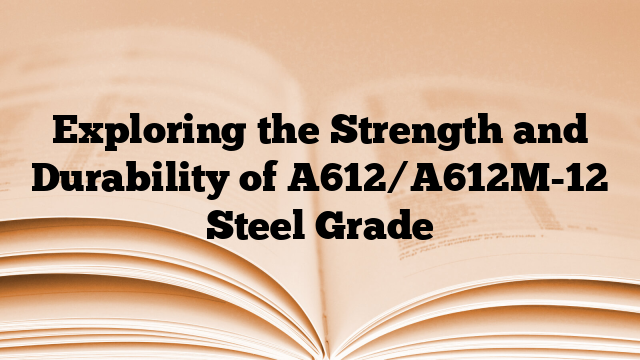There are various factors that affect the strength and durability of A612/A612M-12 steel grade. One of the key factors is the chemical composition of the steel. A612/A612M-12 steel grade is a high-strength low-alloy (HSLA) steel, commonly used in pressure vessels and other structural applications.
The chemical composition of A612/A612M-12 steel grade may vary slightly depending on the manufacturing process and specific requirements. However, the general composition typically includes elements such as carbon (C), manganese (Mn), phosphorus (P), sulfur (S), silicon (Si), and copper (Cu).
The carbon content in A612/A612M-12 steel grade ranges from 0.22% to 0.28%. Carbon provides strength and hardness to the steel, making it suitable for high-stress applications. Manganese is also an important alloying element, ranging from 1.00% to 1.50%. It enhances the strength and hardness of the steel and improves its weldability.
Phosphorus and sulfur are typically limited to a maximum of 0.035% and 0.04%, respectively, to ensure good weldability and avoid brittleness. Silicon is added in small amounts (0.15% to 0.50%) to improve the steel’s strength and workability. Copper, if present, is typically limited to a maximum of 0.35% to prevent corrosion issues.
In terms of mechanical properties, A612/A612M-12 steel grade is known for its excellent strength and toughness. The steel has a minimum yield strength of 345 MPa (50 ksi) and a minimum tensile strength of 550-690 MPa (80-100 ksi). These properties make it suitable for applications where high strength and durability are required.
In addition to the chemical composition and mechanical properties, the A612/A612M-12 steel grade is also governed by a specific standard. The standard number for this steel grade is ASTM A612/A612M-12. This standard provides guidelines and specifications for the manufacturing and testing of A612/A612M-12 steel grade, ensuring its quality and performance.
In conclusion, the strength and durability of A612/A612M-12 steel grade are influenced by its chemical composition, particularly the levels of carbon, manganese, phosphorus, sulfur, silicon, and copper. These elements contribute to the steel’s strength, hardness, and weldability. Additionally, the A612/A612M-12 steel grade is regulated by ASTM A612/A612M-12 standard, which ensures its quality and suitability for various applications.

